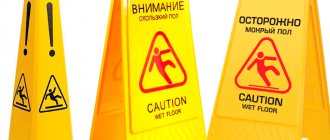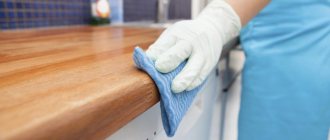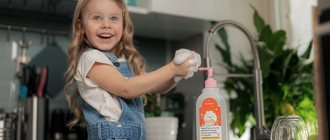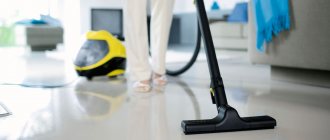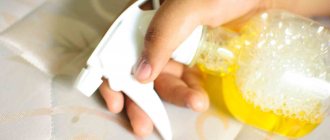A medical institution is an organization in which cleaning must be carried out with particularly high quality.
At the legislative level, requirements are prescribed that apply not only to the process of putting things in order, but also to cleaning equipment.
Read the article about what is included in its package, how to properly store, label, and process cleaning equipment for medical institutions.
What is it regulated by?
The regulations on the procedure for applying markings to cleaning equipment, their storage and rules of use are regulated by the Decree of the Chief Sanitary Doctor of Russia On the approval of SanPiN 2.1.3.2630-10 “Sanitary and epidemiological requirements for organizations engaged in medical activities.”
There is also GOST 58393-2019 “Cleaning services - cleaning services. Cleaning in medical organizations. General requirements".
Ignoring the standards prescribed in these documents is unacceptable. They must be followed by all organizations engaged in medical activities.
Requirements
In a medical facility, it is impossible to refuse cleaning equipment. However, unlike classic cleaning equipment, it is subject to special requirements developed by SanPin:
Equipment must be marked. There is our own equipment for the treatment of sanitary facilities, halls, wards and office premises.- All cleaning equipment is stored in separate rooms, in special cabinets.
- Once cleaning is completed, all equipment should be washed, disinfected and dried.
- Products for reusable use are washed using disinfectant solutions.
- Cleaning workers must wear special clothing and be given rubber gloves, masks, caps, aprons, etc.
- Different equipment is provided for washing walls and floors.
- Only professional equipment can be used for cleaning in medical institutions.
- All cleaning devices must be made of materials that are not destroyed upon contact with disinfectant, alkaline and acidic solutions.
- Mechanized cleaning is possible only with the use of professional equipment with a reduced noise level. Vacuum cleaners and floor washing machines are used only when cleaning in public areas. They are not used in dressing rooms, operating rooms or wards for bedridden patients.
- Napkins for wiping surfaces should be made of materials that quickly absorb and release moisture, and are also not afraid of washing at a temperature of 95 degrees.
- Disinfection carried out for the purpose of prevention is carried out using steam generators.
Existing regular types of cleaning in medical institutions
Disinfection of cleaning rags is a mandatory procedure as part of cleaning in a medical facility. The process is regulated by sanitary rules and is under the control of a senior nurse.
We recommend:
Rating of cordless vacuum cleaners and tips for choosing
Important! The process uses chlorine-containing, alcohol, and aldehyde solutions.
Preliminary
Pre-cleaning is a set of measures aimed at preventing microbial contamination. The purpose of this procedure is to remove dust accumulated overnight and prepare the office for receiving patients.
Note! Preliminary cleaning is the responsibility of the head nurse. In the process, specially designated equipment with appropriate markings is used for each office.
Current
All medical and preventive premises are subject to routine cleaning. When cleaning, different equipment is used, which should not overlap, as well as different schedules.
Features of current cleaning:
- In operating rooms it is carried out after each procedure. Products are used to ensure the complete destruction of viruses and microorganisms both on surfaces and in the air.
- In maternity rooms, routine cleaning is carried out 3 times a day. Products are used to remove microbial contamination.
- The food reception and distribution areas are cleaned after each meal. The mode is virucidal.
- Aseptic rooms require cleaning twice daily. The method is bactericidal.
- In administrative premises, routine cleaning is carried out once a day in order to remove bacterial microflora on surfaces and in the air.
Important! The procedure is carried out by trained personnel in special suits. The materials used are disposed of or processed in accordance with SanPin standards.
Final
Final cleaning is carried out on a daily basis at the end of the working day. As part of the procedure, the removal and disposal of accumulated garbage, air disinfection and dust treatment of surfaces are carried out.
General
General cleaning involves complete cleaning of the office and care of medical equipment. Depending on the type of room, an exact schedule for the procedure is drawn up.
For treatment rooms, examination rooms, and operating rooms, cleaning should be carried out at least once a week. In the administrative and economic parts, wards and doctors’ offices - once a month.
Processing cleaning equipment and rags is an important event on which the cleanliness and hygiene of procedural and administrative premises depends. The process must be carried out in accordance with SanPin standards.
Rate this post
Set of cleaning tools and accessories
The list of tools and devices for cleaning depends on the focus of the medical institution, its area, traffic flow and more.
The classic set looks like this:
- Surface cleaning and disinfection products. They can be liquid, paste-like, granular. All substances must dissolve well. It is possible to use only low-toxic compounds without a pungent odor or irritating effect on mucous membranes or skin.
- Sponges and rags.
- Buckets, containers for treating walls, mops, brushes, screeds, mops.
- Container for detergents and disinfectants.
- Garbage bags.
- For mechanized cleaning: vacuum cleaners, floor washing machines, steam generators.
- Cleaning trolleys.
A medical facility must have all the necessary equipment for both wet and dry cleaning.
If rags and buckets are used for daily activities, then more equipment is required for general cleaning. Its implementation can be simplified with the help of mechanized equipment.
How to properly label and store inventory according to SanPin
Proper storage of disinfectant solutions according to Sanpin
It is necessary to store detergents and disinfectants in packaging from the manufacturer, where there is a label. To do this, you should take separate containers to dilute working disinfection solutions:
- to disinfect and sterilize products for medical purposes, as well as pre-clean these substances;
- to disinfect surfaces on furniture with apparatus, instruments and equipment;
- to disinfect cleaning material, class B and C waste in the absence of disinfection installations.
Containers containing working disinfection solutions must have tight-fitting lids with clear writing or labels.
Color coding is required to more accurately distribute rags and other tools into zones, preventing cross-contamination and bacterial contamination during cleaning activities. Some organizations use four-system color marking and coding to mark buckets, trash cans, mops, telescoping handles, sponges, gloves and other cleaning materials, and to separate cleaning areas. Other companies have colored clips, handles, clips and attachments with tags.
Note! Red coding and markings are used to clean toilets and bathroom floors. This color is often used to mark cleaning areas for sanitary rooms and medical waste areas.
The areas of kitchen tables, bar counters, production facilities and cleanliness in the dining room are marked in green. As a rule, it is used for more efficient cleaning of the dressing room and treatment room.
Tools for cleaning various storage areas are marked in yellow, and wards, staff rooms and corridors are marked in blue.
Service
Equipment that has been used must be properly maintained.
Three main stages:
- disinfection using specialized solutions;
- rinsing in clean water;
- drying.
Only after completing these procedures can it be sent for storage. It is recommended to use disposable wipes for cleaning. If this is not possible, they resort to using reusable products, with their obligatory washing.
Washing machines for this purpose are installed in those places where cleaning carts are collected. Squeegees, mop holders and brushes are treated after each use .
Before using reusable mops and napkins for the first time, they need to be washed to remove the impregnation applied by the manufacturer, make them softer and increase absorbency.
For washing, it is recommended to use liquid detergents, which are better washed out of textiles. Avoid using rinse aids.
Marking
Labeling of cleaning equipment in medical institutions is mandatory. It is necessary to prevent the spread of infection during cleaning.
Marking can be applied in the following way:
- If a medical institution uses equipment without color gradation, then marks are applied to it using indelible paint. Buckets, basins and other containers are marked on the outside.
- Reusable cloth napkins and rags are labeled by sewing small pieces of fabric in the desired color. Flannel napkins are not marked.
- Markings may be burned into brush handles.
- Buckets and brushes for cleaning in the toilet are marked with the letters “UB”, for other rooms - “For floors”, for the surfaces of sofas and seats - “For sofas”, for processing equipment - “For equipment”.
There is also a “Quad” classification that divides inventory by color:
- To process sanitary and utility rooms where garbage and dirty laundry are stored, red equipment is used. This indicates that it can only be used to service premises with significant bacterial contamination of surfaces.
- Green equipment is used to care for furniture, treat treatment tables, and dressing stations. This color indicates that the requirements for cleanliness at such facilities are extremely high.
- To treat rooms with low sanitary requirements, equipment marked in blue is used.
- The rest of the furniture, surfaces and products are washed with equipment marked in yellow.
Blue equipment is used for processing staff rooms, canteens, halls and other public areas.
Origin story
People began to use rags in ancient times. There is information that cleaning material was used in Ancient Egypt. Craftsmen used pieces of rags to remove shavings and polished the products. These technologies have been used for centuries.
The modern history of cotton wiping rags began in the 18th century, at the moment when the industrial revolution took place. At the moment when the first machines began to be used in factories, the use of rags became widespread. Modern roll rags did not yet exist; they appeared much later - only in the 20th century. Today, the material is actively used in almost all economic sectors and everyday life.
Storage rules
Rules for storing cleaning equipment:
- Only equipment that has clear markings is sent for storage - if it has become illegible, it needs to be updated;
- It is prohibited to use equipment for other purposes;
- all cleaning equipment should be stored in special cabinets - mops and brushes are placed vertically, mounted on special holders;
- do not store brushes, buckets and rags that are used for cleaning in different rooms together;
- Only disinfected buckets, mops, etc. are put away for storage;
- you cannot leave inventory for storage anywhere other than a special room;
- disinfectants and detergents must be stored in the manufacturer’s packaging, with the label intact;
- sanitary rooms should be equipped with sinks, they should provide places for storing garbage and materials that have become unusable; it is desirable to have outlets with low taps for collecting water in buckets.
Compliance with storage rules is a prerequisite for working with equipment in medical institutions. Failure to comply with them may cause the spread of infections.
All working personnel must be familiarized with the rules for working with cleaning devices.
Disinfection of cleaning equipment
Cleaning equipment must be disinfected after use. So, to disinfect rags, you need a separate container (for example, a bucket) and a disinfectant solution. The algorithm for disinfecting rags looks like this:
- The rags are completely immersed in a container with a disinfectant solution and left for the disinfection period;
- At the end of the exposure, the rags are removed from the disinfectant solution and washed under running water;
- The washed rags are dried;
- After complete drying, the rags are stored in a labeled container (for example, boxes).
Removable mops are also processed using the same principle.
Mops are disinfected by wiping with a rag soaked generously in a disinfectant. Then rinse them with running water and dry.
Carts for cleaning equipment are disinfected by wiping with a rag soaked in disinfectant. means. After that, the remaining disinfectant is removed with a clean rag soaked in water.
Buckets and other containers used for cleaning should be stored separately. Buckets cannot be inserted into one another.



